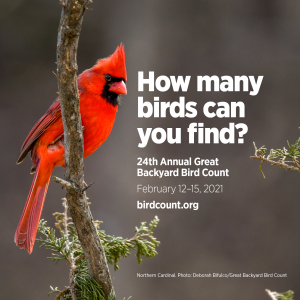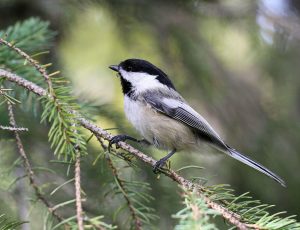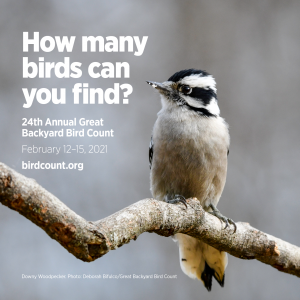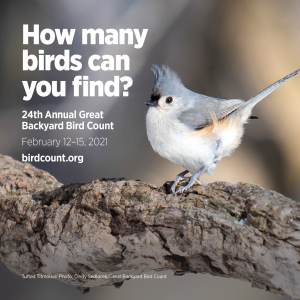
The vibrant and active world of birds has long been a fascinating field of discovery. Bird watching offers a safe and enjoyable way to connect with nature and provides a sense of excitement when seeing something new. So, perhaps you too, like so many others this past year, found yourself entranced by the flittering feathers outside your window? Regardless of your experience, bird lovers from all over the world are invited to participate in the Great Backyard Bird Count!
Participating is easy, fun to do alone, or with others, and can be done anywhere you find birds. Simply watch birds for 15 minutes or more, at least once over the four days, February 12-15, 2021, and report back what you see!
Learn more about how to participate in the Great Backyard Bird Count!
To help get ready for the count this weekend, we’re reaching into the NPC blog vault to reshare some insight on some of our area’s more “popular” backyard birds, by former NPC Land Steward, Charlie Schwartz.
Northern Cardinal

Northern cardinals are usually the most colorful birds to visit backyard feeders where they feast on sunflower and other seeds. Male cardinals are bright red beneath and brownish red on their backs; females are much more brown which offers better concealment when they incubate their eggs in an open nest in dense shrubbery. Cardinals prefer brushy habitat dominated by shrubs and small trees; that is why they are fairly common in residential neighborhoods containing many shrubs. Males sing loudly in spring and females also occasionally sing. Cardinals are crepuscular meaning that they are most active at dawn or dusk; they are often the last birds to visit a feeder in the evening. As the climate changes and winters get warmer, cardinals have been extending their range northward into northern New England and southern Canada.
Audubon and National Geographic both have some great information on the Northern Cardinal and its range. You can also visit the Cornell Lab of Ornithology’s YouTube channel to hear the Northern Cardinal’s song.
Black-Capped Chickadee

Photo: John Pizniur Audubon Photography Award
One of the most popular birds is the black-capped chickadee, which some people call “the little boy of the woods” for their constant motion and apparent joie di vivre. Black-capped chickadees are found from southern Pennsylvania to the northern limit of trees in Canada and frequent a multitude of habitats from old growth forests to reverting brushy fields. They nest in tree cavities, old woodpecker holes and in nest boxes; they spend winter nights in similar locations. It has been reported that chickadees have about two hours to find food each morning before lack of nourishment proves fatal. At feeders they prefer sunflower seeds but will also eat corn, suet and peanut butter; they frequently cache surplus food for use later. Remarkably, their brains actually produce new cells and grow by about 30% in fall so they can remember all those cache sites (up to 100,000) and then shrink in the spring.
For information on black-capped chickadee habitat, bird’s song and more, visit these additional resources: Cornell Lab of Ornithology, National Geographic, and Birdzilla.
Downy Woodpecker

Downy woodpeckers are our smallest woodpecker and like chickadees are found in a wide variety of habitats. They are common in residential neighborhoods that contain fairly large trees where they nest in small cavities that they excavate in soft or decaying wood. Also like chickadees, they spend winter nights in cavities where they are protected from cold temperatures and chilling winds. Downy woodpeckers will visit feeders to feast on suet and peanut butter and will even eat corn and sunflower seeds by wedging them in bark crevices and pounding them open. Along with chickadees, titmice, nuthatches and brown creepers, downy woodpeckers will form a feeding cohort that travels through woodland. Each species in the cohort has a different feeding strategy and thus does not compete against the others. Male downy woodpeckers have a small red spot on the back of their heads, which females lack.
For information on downy woodpecker habitat, bird’s song and more, visit these additional resources: Cornell Ornithology Lab, National Geographic’s website or Audubon.
Tufted Titmice

Fifty years ago it was an unusual occurrence to have a number of tufted titmice visiting a feeder in northcentral Pennsylvania every day. Following a hard winter they might disappear for a year or more until young birds wandering into territories unoccupied since the death of the previous residents re-established a population. As winters have warmed over the last few decades the tufted titmouse, generally considered a southern species, have become permanent and common residents of woodlands, fencerows, brushy fields and suburban areas in northcentral Pennsylvania. Titmice frequently are members of feeding cohorts which include chickadees, nuthatches, and downy woodpeckers – each species feeds on similar food items but has a different method of foraging and thus don’t actually compete for food.
But, if we think of bird feeders as the avian equivalent of a fancy restaurant it should be readily apparent that feeders are not the be-all and end-all of what these birds need. They also need a place to live – correctly called habitat. That habitat must include winter roosting sites and nesting site, both being tree hollows or similar cavities, as well as other sources of food including insects and cover in which to escape inclement weather and predators.
The Cornell Lab of Ornithology has a recording of the tufted titmouse’s song on their website. If you visit National Geographic’s website you’ll see drawings of a juvenile and adult as well as a map showing their range.

